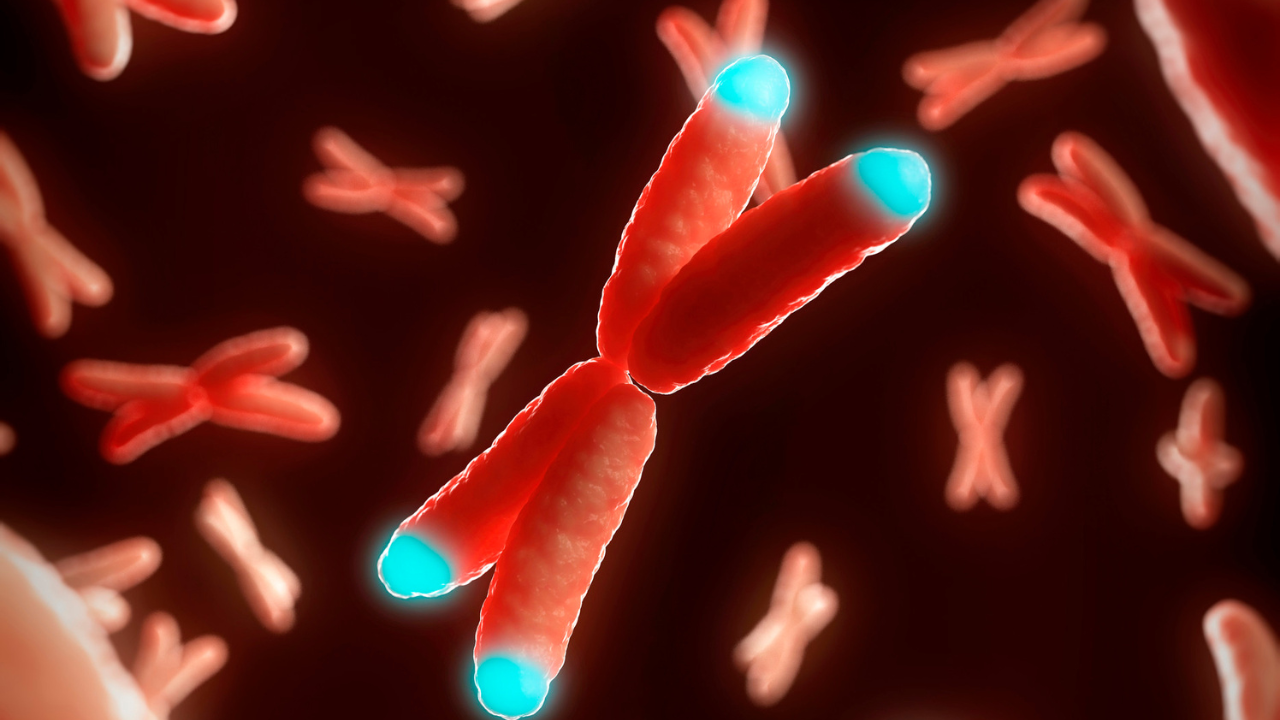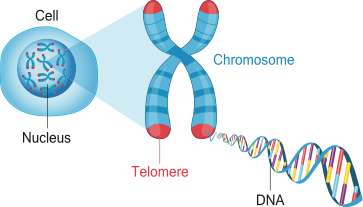Telomeres: Protecting Our DNA

DNA exists in our cells as tightly coiled sequences called chromosomes. Each cell has 23 pairs. Every time our cells divide to create new cells, our DNA also has to get divided and replicated. In order to do this, the chromosomes have to unwind and become vulnerable to damage and breaks.
Telomeres Are Part of Our DNA
Telomeres are specific sequences of DNA on the ends of our chromosomes that are designed to protect them from getting tangled or damaged during this process. This minimizes the risk of large-scale errors in the DNA when the chromosomes get transferred to the newly created cells.

But telomeres also have another function: they are also part of a cell’s biological clock. Telomeres shorten over time, and one of the main ways this happens is when cells divide. The more times a cell divides, the shorter the telomeres get.
Telomere Length for Biological Aging
Eventually the telomere becomes too short to protect the chromosomes reliably, and so the cell dies. In this way, the length of the telomeres can provide a good estimation of how many times the chromosomes have been replicated to form new cells. [1]
It is also possible to increase telomere length, and so the resulting telomere length is the interaction of multiple factors.
Biological sex and genetics are two such factors that can affect telomeres. Estrogen, the sex hormone found in much higher levels in females, tends to be associated with longer telomere length. Errors in a person’s genes, whether due to rare inherited genetic mutations or more common smaller changes called SNPs (single nucleotide polymorphisms) can lead to shorter telomeres. [2]
Short Telomeres Cause Aging
And telomere length matters. Shorter telomeres are associated with an increased risk for many diseases associated with aging, including cancer, heart disease, diabetes, osteoporosis, and Alzheimer’s Disease. [3]
So are longer telomeres better? Not necessarily.
Studies have shown that telomere length is typically longer in cancer cells, because they have hijacked the normal internal clock. This is one reason why cancer cells can continue to multiply much faster and longer than normal cells.
But cancer is not the only way to lengthen telomeres.
Role of Diet, Lifestyle and Genes
Dietary and lifestyle factors have also been shown to affect the length of telomeres. Chronic stress, poor diet, environmental toxins (including smoking), and lack of adequate exercise have all been linked to shorter telomeres, primarily by increasing the levels of oxidative stress. [2]
Not everyone who experiences these stressors ends up with the same length telomeres, however.
All of these interactions are under the control of genes, and having multiple errors in these genes called SNPs (single nucleotide polymorphisms) can make a big difference in how much these factors affect telomere length.
The good news is that a person’s short telomere length is not irreversible. Recent studies have shown that providing the right diet, lifestyle, and nutritional supplements to reduce oxidative stress can reverse this process of telomere shortening over time. [2]
The first step is to know how healthy your telomeres are.
Get Your BioAge Now
References:
1) Genome.gov
2) Tsoukalas, D et al Association of nutraceutical supplements with longer telomere length. Int J Mol Med. 2019 Jul; 44(1): 218–226
3) Gruber HJ et al. Telomeres and Age-Related Diseases. Biomedicines 2021, 9, 1335.
